
(a)
Interpretation: The acceptable names for the given compounds are to be predicted.
Concept introduction:
• The hydrocarbon is named after the longest carbon chain.
• The parent hydrocarbon containing ester group is named with suffix “ate”.
• The alkyl group bonded to oxygen through single bond forms the first part of the ester and alkyl group bonded to carbonyl group forms the second part.
Answer to Problem 22.38P
The acceptable name of the compound A is
Explanation of Solution
The given compound A is,
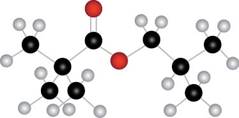
Figure 1
The red coloured ball has two bonds. So, this is the oxygen atom. The black coloured atoms have four single bonds. So, these are the carbon atoms. The grey coloured balls have one bond. So, these are the hydrogen atoms. The molecular structure of the compound is,
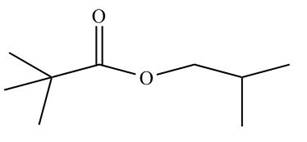
Figure 2
This compound contains ester group. The alkyl group attached to carbonyl group has longest chain of three carbon atoms with two methyl groups substituted at the second carbon atom. The alkyl group bonded to oxygen through single bond has longest chain of three carbon atoms with one methyl group substituted at the second carbon atom. The acceptable name of the compound is
The given compound B is,

Figure 3
The blue coloured ball has three bonds. So, this is the nitrogen atom. The black coloured atoms have four bonds. So, these are the carbon atoms. The grey coloured balls have one bond. So, these are the hydrogen atoms. The molecular structure of the compound is,
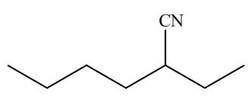
Figure 4
The given compound B contains longest chain of six carbon atoms with ethyl group substituted at the second carbon atom. The acceptable name of the compound is
The acceptable name of the compound A is
(b)
Interpretation: The products formed on treatment of A or B with given reagents: [1]
Concept introduction: The metal hydride reagents are good reducing agents such as
When the esters and nitriles are hydrolyzed to carboxylic acids in acidic medium and in basic medium carboxylate ions are formed.
Grignard reagents are organometallic compounds which are prepared using alkyl halides in the presence of magnesium metal in dry ether. These reagents act as strong nucleophiles and bases.
Answer to Problem 22.38P
The reaction of compound A with given reagents are shown below.
[1]
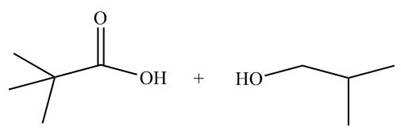
Figure 5
[2]
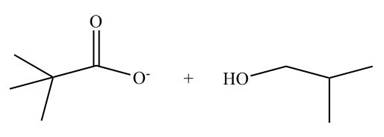
Figure 6
[3]
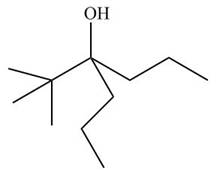
Figure 7
[4]
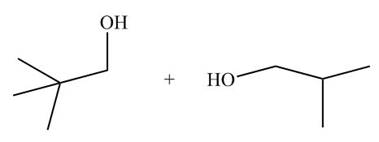
Figure 8
The reaction of compound B with given reagents are shown below.
[1]
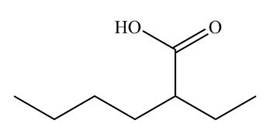
Figure 9
[2]
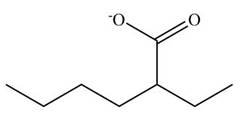
Figure 10
[3]
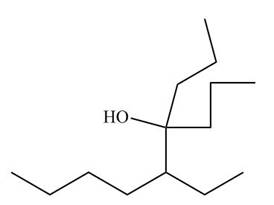
Figure 11
[4]

Figure 12
Explanation of Solution
The reaction of compound A with given reagents are shown below.
[1]
The ester group undergoes acidic hydrolysis to form alcohol and

Figure 13
The products formed are
[2]
The ester group undergoes basic hydrolysis to form alcohol and carboxylic acid as shown below.

Figure 14
The products formed are
[3]
The given ester compound reacts with excess Grignard reagent followed by hydrolysis to form
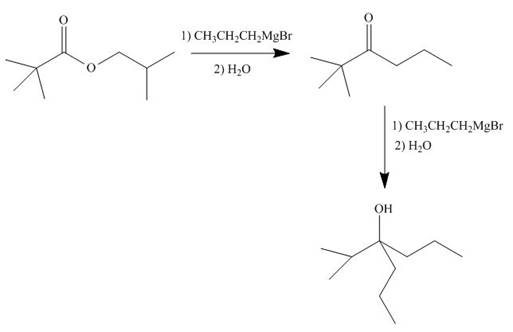
Figure 15
The product formed is form
[4]
In presence of lithium aluminium hydride, the ester group is reduced to two alcohols. The corresponding reaction is shown below.

Figure 16
The products formed are
The reaction of compound B with given reagents are shown below.
[1]
The cyano group undergoes acidic hydrolysis to form carboxylic acid as shown below.

Figure 17
The products formed is
[2]
The cyano group undergoes basic hydrolysis to form carboxylate ion as shown below.

Figure 18
The product formed is
[3]
The nitrile compound reacts with Grignard reagent to form alcohol. The corresponding reaction is shown below.

Figure 19
[4]
In the presence of lithium aluminium hydride, the ester group is reduced to two alcohols. The corresponding reaction is shown below.

Figure 20
The product formed is
The products formed on treatment of A or B with given reagents: [1]
Want to see more full solutions like this?
Chapter 22 Solutions
Organic Chemistry
- Epoxides can be opened in aqueous acid or aqueous base to produce diols (molecules with two OH groups). In this question, you'll explore the mechanism of epoxide opening in aqueous acid. 2nd attempt Be sure to show all four bonds at stereocenters using hash and wedge lines. 0 0 Draw curved arrows to show how the epoxide reacts with hydronium ion. 100 +1: 1st attempt Feedback Be sure to show all four bonds at stereocenters using hash and wedge lines. See Periodic Table See Hint H A 5 F F Hr See Periodic Table See Hintarrow_forward03 Question (1 point) For the reaction below, draw both of the major organic products. Be sure to consider stereochemistry. > 1. CH₂CH₂MgBr 2. H₂O 3rd attempt Draw all four bonds at chiral centers. Draw all stereoisomers formed. Draw the structures here. e 130 AN H See Periodic Table See Hint P C Brarrow_forwardYou may wish to address the following issues in your response if they are pertinent to the reaction(s) you propose to employ:1) Chemoselectivity (why this functional group and not another?) 2) Regioselectivity (why here and not there?) 3) Stereoselectivity (why this stereoisomer?) 4) Changes in oxidation state. Please make it in detail and draw it out too in what step what happens. Thank you for helping me!arrow_forward
- 1) Chemoselectivity (why this functional group and not another?) 2) Regioselectivity (why here and not there?) 3) Stereoselectivity (why this stereoisomer?) 4) Changes in oxidation state. Everything in detail and draw out and write it.arrow_forwardCalculating the pH at equivalence of a titration 3/5 Izabella A chemist titrates 120.0 mL of a 0.7191M dimethylamine ((CH3)2NH) solution with 0.5501 M HBr solution at 25 °C. Calculate the pH at equivalence. The pk of dimethylamine is 3.27. Round your answer to 2 decimal places. Note for advanced students: you may assume the total volume of the solution equals the initial volume plus the volume of HBr solution added. pH = ☐ ✓ 18 Ar Boarrow_forwardAlcohols can be synthesized using an acid-catalyzed hydration of an alkene. An alkene is combined with aqueous acid (e.. sulfuric acid in water). The reaction mechanism typically involves a carbocation intermediate. > 3rd attempt 3343 10 8 Draw arrows to show the reaction between the alkene and hydronium ion. that 2nd attempt Feedback 1st attempt تعمال Ju See Periodic Table See Hint F D Ju See Periodic Table See Hintarrow_forward
- Draw the simplified curved arrow mechanism for the reaction of acetone and CHgLi to give the major product. 4th attempt Π Draw the simplified curved arrow mechanism T 3rd attempt Feedback Ju See Periodic Table See Hint H -H H -I H F See Periodic Table See Hintarrow_forwardSelect the correct reagent to accomplish the first step of this reaction. Then draw a mechanism on the Grignard reagent using curved arrow notation to show how it is converted to the final product. 4th attempt Part 1 (0.5 point) Select the correct reagent to accomplish the first step of this reaction. Choose one: OA Mg in ethanol (EtOH) OB. 2 Li in THF O C. Li in THF D. Mg in THF O E Mg in H2O Part 2 (0.5 point) Br Part 1 Bri Mg CH B CH, 1 Draw intermediate here, but no arrows. © TE See Periodic Table See Hint See Hint ין Harrow_forwardSelect the product for the following reaction. HO HO PCC OH ○ OH O HO ○ HO HO HOarrow_forward
- 5:45 Х Select the final product for the following reaction sequence. O O 1. Mg. ether 2.D.Oarrow_forwardBased on the chart Two similarities between the molecule with alpha glycosidic linkages. Two similarities between the molecules with beta glycosidtic linkages. Two differences between the alpha and beta glycosidic linkages.arrow_forwardplease help fill in the tablearrow_forward
 Chemistry: Principles and ReactionsChemistryISBN:9781305079373Author:William L. Masterton, Cecile N. HurleyPublisher:Cengage Learning
Chemistry: Principles and ReactionsChemistryISBN:9781305079373Author:William L. Masterton, Cecile N. HurleyPublisher:Cengage Learning Organic ChemistryChemistryISBN:9781305580350Author:William H. Brown, Brent L. Iverson, Eric Anslyn, Christopher S. FootePublisher:Cengage Learning
Organic ChemistryChemistryISBN:9781305580350Author:William H. Brown, Brent L. Iverson, Eric Anslyn, Christopher S. FootePublisher:Cengage Learning

